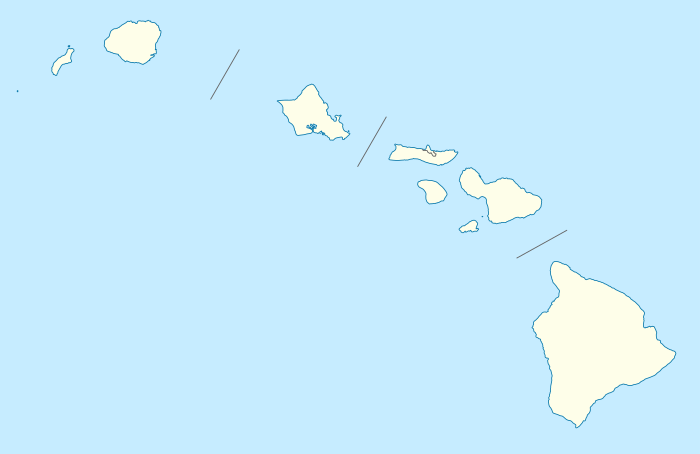Bobcat Trail Habitation Cave
Bobcat Trail Habitation Cave is a historic site of Ancient Hawaiian living quarters in a remote interior area of the island of Hawaiʻi.
Bobcat Trail Habitation Cave (50-10-30-5004) | |
 | |
| Location | Central Hawaiʻi Island |
|---|---|
| Coordinates | 19°38′6″N 155°41′55″W |
| Area | 0.3 acres (0.12 ha) |
| Built | 1449-1500 |
| Architectural style | Ancient Hawaiian |
| NRHP reference No. | 86001086[1] |
| Added to NRHP | May 15, 1986 |
Location
Coordinates are approximate; The site is within the Puuanahulu ahupuaʻa (region) of the North Kona District on the island of Hawaiʻi. The exact location is kept restricted to avoid damage to the site. It is on U.S. Federal land which is part of the Pohakuloa Training Area.[2] At an elevation of 5,100–9,000 ft (1,600–2,700 m), the arid area receives only 20 in (510 mm) of rainfall per year. The vegetation is a mix of subalpine and montane dry shrublands.
It is named for the nearby Bobcat Trail, which has been proposed to be restored into part of a Mauna Loa trail system.[3]
History
The trail was part of a system used before the time of King ʻUmi, who moved the royal residence to a site nearby on the same high plateau in the 16th century, now called Ahu A ʻUmi Heiau. Original studies were focused on the coastal areas that remain inhabited today, but even this more marginal area has evidence of human activity from A.D. 700 until the 18th century. Ancient Hawaiians hunted birds and gathered wood extensively on the plateau. They valued both seabirds that nested here for food, and forest birds for colorful feathers used in ceremonial garments. While hunting, they camped in the caves formed by Lava tubes, placing gourds on the floor to collect water that dripped from the ceiling. The forests provided sandalwood and medicinal plants. Bundles of sandalwood were found where they were left for later transport to the larger communities on the coast.[2]
Protection
The site is state archaeological site number 10-30-5004[4] (this number, plus "50-" to indicate the state of Hawaii, was appended to its name on the National registry). It was added to the National Register of Historic Places on May 15, 1986 as site number 86001086.[1] In 1995 a comprehensive survey of the area was funded by the U.S. Army to produce an environmental management plan.[5] In 2004, another study was done for some proposed improvements to the training area. Although this cave is the only one listed on the register, there are several others in the area.[6]
See also
- Native American Graves Protection and Repatriation Act
- Contributing property
- Cultural landscape
- Historic preservation
- Keeper of the Register
- List of heritage registers
- Property type (National Register of Historic Places)
- United States National Register of Historic Places listings
- State Historic Preservation Office
References
- "National Register Information System". National Register of Historic Places. National Park Service. July 9, 2010.
- "Managing Cultural Resources in a Multi-Use Area" Archived January 9, 2009, at the Wayback Machine by Jadelyn J. Moniz Nakamura, in Cultural Resource Management, on National Park Service web site, Volume 21 Number 8, 1998
- "Historic Sites Review of a Proposed Mauna Loa Trail System" Archived 2006-12-15 at the Wayback Machine by Thomas S. Dye, March 25, 2005, on Nature Conservancy web site
- List of Historic Places in Hawaii County Archived 2009-05-27 at WebCite on Hawaii State web site
- Cleghorn and Clark, "Initial Implementation of the Historic Preservation Plan for Bobcat Trail Habitation Cave (Site 50-10- 30-5004)" submitted to the U.S. Army Engineer District, Honolulu, Fort Shafter, Hawaiʻi, 1996
- Environmental Impact Statement for the 24th Light Infantry Division, on U.S. Army web site
Further reading
- Athens, J.S; M. W. Kaschko (1989). Prehistoric Upland Bird Hunters: Archaeological Inventory Survey and testing for the MPRC Project Area and the Bobcat Trail Road, Pōhakuloa Training Area, Island of Hawaiʻi. Honolulu Hawaii: Prepared for the US Army Corps of Engineers, Pacific Ocean Division, Fort Shafter, Hawaii. International Archaeological Research Institute, Inc.
- Haun, Alan E. (1986). Archaeological Survey and Testing at the Bobcat Trail Habitation Cave Site (50-10-30-5004), Pōhakuloa Training Area, Island of Hawaiʻi, Hawaiʻi. Honolulu, HI: Prepared for the USACE, Honolulu District, Fort Shafter, Hawaii by Paul H. Rosendahl, Inc.